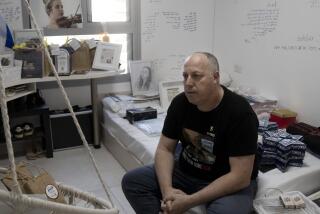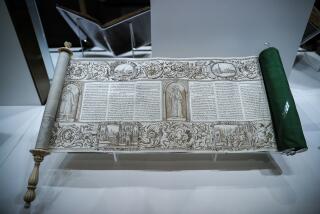The Lessons of the Sarajevo Hagaddah : Passover: This wondrous book has survived centuries of wars and pogroms and still carries its hopeful message.
- Share via
As Jewish families the world over gather around dining tables to commemorate Passover, they will recount the story of the exodus from Egypt by reading from the ages-old book that tells this tale: the Hagaddah. Millions of Hagaddahs exist, from freshly printed paperbacks to elaborate editions dating back decades, even centuries. But the most famous Hagaddah in the world, worth more than $10 million, lies hidden in a secret location in the war-ravaged city of Sarajevo. How it got there and why it remains is a story that combines the best elements of the Maltese Falcon and Indiana Jones, only this is not fiction; it is much too strange for that.
Little is known about this Hagaddah, save that a long-forgotten Jewish family commissioned it in Spain (probably Barcelona) around 1350. Surely they were wealthy--before the printing press, who else could have commissioned an artist to craft 34 miniature paintings lined with gold and copper leaf onto pages made of the finest leather? But as were the Spanish Jews, this Hagaddah was cast out of the country in 1492 and drifted around the Mediterranean for centuries, picking up a mysterious note of sale in 1510 here, the approval of anItalian church censor in 1610 there.
In 1894, an impoverished family by the name of Kohen walked into a Sarajevo museum, sold the book for a pittance, and slipped back into the obscurity from whence they came. Scholars realized that they had been handed a magnificent find, and the monograph published in 1898 said so. It hit the art world like a bombshell, launching the Hagaddah’s fame, but the book has never been on public display.
During World War II, while most of Sarajevo’s Jews were being deported to their deaths, a Wehrmacht general, Johann Fortner, went hunting for the Hagaddah in the National Museum. Two heroic museum workers foiled him: one was a Croat, the other a Muslim. While one was lying to the German, the other spirited the Hagaddah out of harm’s way. Where it went during the rest of the war is a mystery; I have heard that it was kept hidden by Muslim shepherds, Catholic monks and Serb peasants.
When war returned in 1992, another museum worker, Enver Imamovic, dodged machine gun fire and broke open the safe housing the book and spirited it away. He has never said where he took it. When he agreed to take me to visit the book last month in Sarajevo, I had to sign a ream of permissions and pledges promising not to divulge the location. That 11 men with machine guns surrounded me as I signed the papers and finally peeked at the great book added some weight to the event.
As for why the Hagaddah remains in Sarajevo, the story gets even better. As the city was pummeled with mortars and raked with sniper fire for a thousand days while 10,000 people were murdered and 50,000 wounded, the mysterious book that survived seven centuries of pogroms, expulsions and genocide turned into a symbol of survival for all Sarajevans. After all, the Spanish refugee Jews who came to this city hundreds of years ago never lived in a ghetto and they were, by and large, well-accepted. Today, only a handful of Holocaust survivors and their offspring remain in Bosnia. Those who stayed have set up their own humanitarian aid agency inside the synagogue. Taking the lessons of the Hagaddah to heart, they are helping all their neighbors: Muslims, Serbs and Croats alike.
Sarajevo’s fabled multiethnic character has been badly and permanently wounded in this war, but for those who know this city, there is still reason to hope that it can be nursed back to health. And why not? The only reason Sarajevo survived at all is because while we looked on from the outside, inside the city that became a ghetto, neighbor helped neighbor, friend stood by friend.
In so doing, their actions have taken the words of their (and every) Hagaddah and put them to work: This is the bread of affliction our ancestors ate while they were slaves in Egypt. All who are hungry, let them come and eat; all who are in need of fellowship, let them come celebrate Passover with us.
Jewish law says Passover lasts eight days. In Sarajevo, it lasted more than a thousand.
More to Read
Sign up for our Book Club newsletter
Get the latest news, events and more from the Los Angeles Times Book Club, and help us get L.A. reading and talking.
You may occasionally receive promotional content from the Los Angeles Times.










